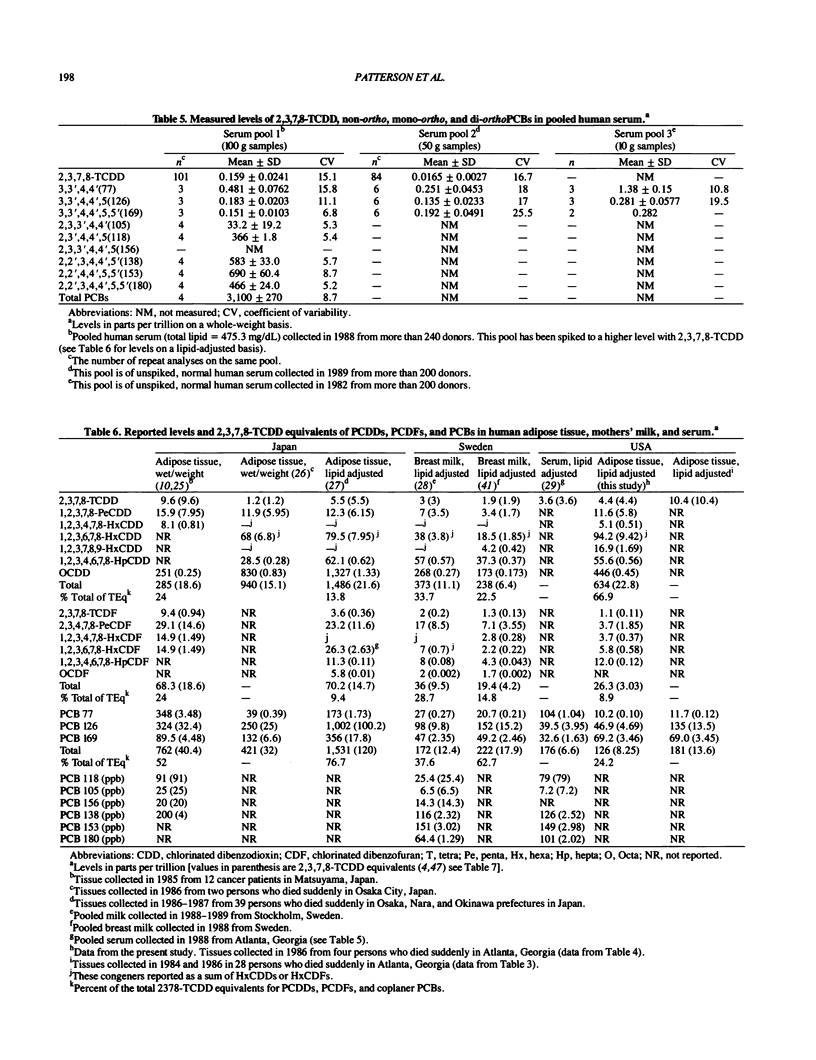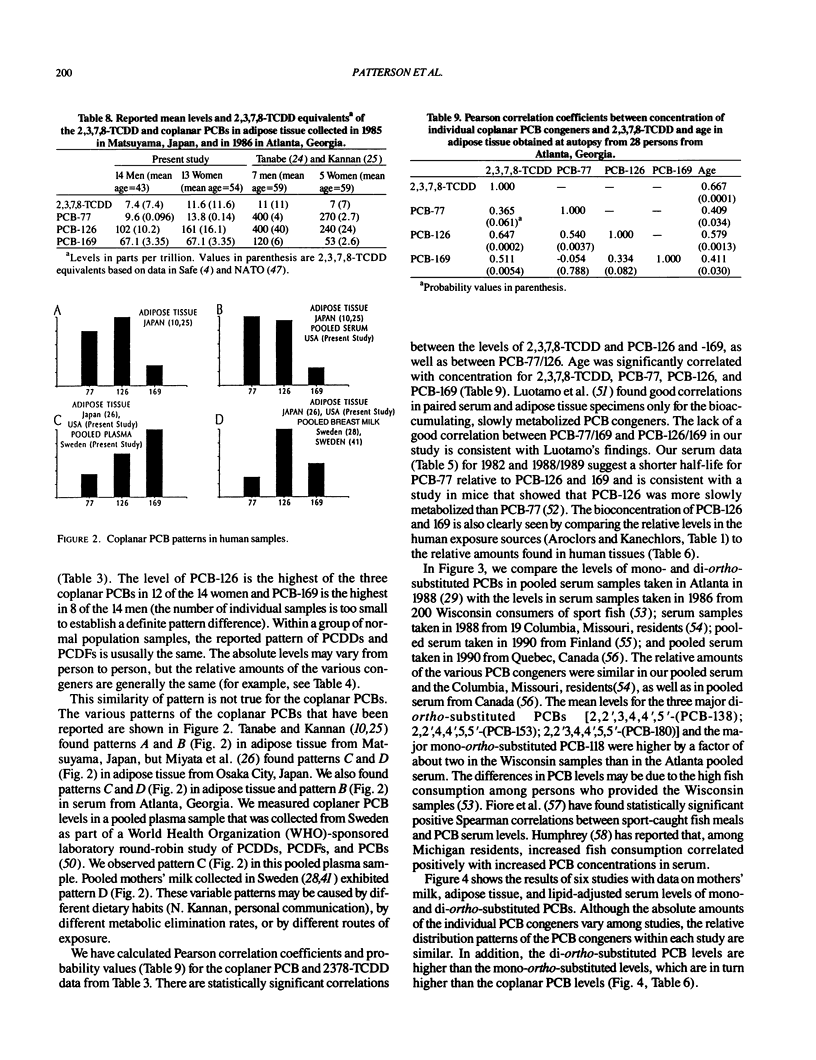Abstract
We have measured non-ortho-substituted (coplanar) polychlorinated biphenyl (PCB) levels as well as polychlorinated dibenzo-p-dioxin (PCDD) and polychlorinated dibenzofuran (PCDF) levels in human adipose tissue and serum collected in Atlanta, Georgia. The results show that the concentrations of the coplanar PCBs can be more than an order of magnitude higher than the concentrations of 2,3,7,8-tetrachlorodibenzo-p-dioxin. Our measurements in pooled serum collected in 1982, 1988, and 1989 show a decrease in coplanar PCB levels from 1982 to 1989. We found that the pattern of relative amounts of coplanar PCBs in adipose tissue varied greatly from person to person unlike the PCDD and PCDF patterns, which were more nearly the same. Age was significantly correlated with the concentrations of 2,3,7,8-TCDD,3,3'4,4'-PCB, 3,3',4,4',5-PCB, and 3,3'4,4',5,5'-PCB in adipose tissue. We also measured levels of the mono- and di-ortho chlorine-substituted PCBs in human serum. The levels for some of these PCB congeners were three orders of magnitude higher than the coplanar PCBs, PCDDs, and PCDFs. We used the international toxicity equivalency factors (TEFs) for PCDDs and PCDFs and the TEFs proposed by Safe for PCBs to calculate the 2,3,7,8-TCDD equivalents. Four PCBs (3,3',4,4',5-; 2,3',4,4',5-;2,3,3',4,4'-;2,3,3',4,4',5-) make a larger contribution than 2,3,7,8-TCDD, while four other PCBs (3,3',4,4'5,5'-; 2,2',3,4,4',5'-;2,2',4,4',5,5'-;2,2',3,4,4',5,5'-) make nearly the same contribution as 2,3,7,8-TCDD. The mono-ortho-chlorine-substituted 2,3',4,4',5-PCB, however, is the major contributor to the total 2,3,7,8-TCDD equivalents in general population samples from the United States, Sweden, and Japan.(ABSTRACT TRUNCATED AT 250 WORDS)
Full text
PDF









Selected References
These references are in PubMed. This may not be the complete list of references from this article.
- Abdel-Hamid F. M., Moore J. A., Matthews H. B. Comparative study of 3,4,3',4'-tetrachlorobiphenyl in male and female rats and female monkeys. J Toxicol Environ Health. 1981 Feb;7(2):181–191. doi: 10.1080/15287398109529971. [DOI] [PubMed] [Google Scholar]
- Akins J. R., Waldrep K., Bernert J. T., Jr The estimation of total serum lipids by a completely enzymatic 'summation' method. Clin Chim Acta. 1989 Oct 16;184(3):219–226. doi: 10.1016/0009-8981(89)90054-5. [DOI] [PubMed] [Google Scholar]
- Burse V. W., Groce D. F., Korver M. P., McClure P. C., Head S. L., Needham L. L., Lapeza C. R., Jr, Smrek A. L. Use of reference pools to compare the qualitative and quantitative determination of polychlorinated biphenyls by packed and capillary gas chromatography with electron capture detection. Part 1. Serum. Analyst. 1990 Mar;115(3):243–251. doi: 10.1039/an9901500243. [DOI] [PubMed] [Google Scholar]
- Fiore B. J., Anderson H. A., Hanrahan L. P., Olson L. J., Sonzogni W. C. Sport fish consumption and body burden levels of chlorinated hydrocarbons: a study of Wisconsin anglers. Arch Environ Health. 1989 Mar-Apr;44(2):82–88. doi: 10.1080/00039896.1989.9934380. [DOI] [PubMed] [Google Scholar]
- Kannan N., Tanabe S., Ono M., Tatsukawa R. Critical evaluation of polychlorinated biphenyl toxicity in terrestrial and marine mammals: increasing impact of non-ortho and mono-ortho coplanar polychlorinated biphenyls from land to ocean. Arch Environ Contam Toxicol. 1989 Nov;18(6):850–857. doi: 10.1007/BF01160300. [DOI] [PubMed] [Google Scholar]
- Kannan N., Tanabe S., Tatsukawa R. Potentially hazardous residues of non-ortho chlorine substituted coplanar PCBs in human adipose tissue. Arch Environ Health. 1988 Jan-Feb;43(1):11–14. doi: 10.1080/00039896.1988.9934366. [DOI] [PubMed] [Google Scholar]
- Lapeza C. R., Jr, Patterson D. G., Jr, Liddle J. A. Automated apparatus for the extraction and enrichment of 2,3,7,8-tetrachlorodibenzo-p-dioxin in human adipose tissue. Anal Chem. 1986 Apr;58(4):713–716. doi: 10.1021/ac00295a011. [DOI] [PubMed] [Google Scholar]
- Leece B., Denomme M. A., Towner R., Li S. M., Safe S. Polychlorinated biphenyls: correlation between in vivo and in vitro quantitative structure-activity relationships (QSARs). J Toxicol Environ Health. 1985;16(3-4):379–388. doi: 10.1080/15287398509530748. [DOI] [PubMed] [Google Scholar]
- Luotamo M., Järvisalo J., Aitio A. Assessment of exposure to polychlorinated biphenyls: analysis of selected isomers in blood and adipose tissue. Environ Res. 1991 Apr;54(2):121–134. doi: 10.1016/s0013-9351(05)80095-7. [DOI] [PubMed] [Google Scholar]
- Mes J., Davies D. J., Turton D. Polychlorinated biphenyl and other chlorinated hydrocarbon residues in adipose tissue of Canadians. Bull Environ Contam Toxicol. 1982 Jan;28(1):97–104. doi: 10.1007/BF01608420. [DOI] [PubMed] [Google Scholar]
- Millis C. D., Mills R. A., Sleight S. D., Aust S. D. Toxicity of 3,4,5,3',4',5'-hexabrominated biphenyl and 3,4,3',4'-tetrabrominated biphenyl. Toxicol Appl Pharmacol. 1985 Mar 30;78(1):88–95. doi: 10.1016/0041-008x(85)90308-4. [DOI] [PubMed] [Google Scholar]
- Mori Y., Kikuta M., Okinaga E., Okura T. Levels of PCBs and organochlorine pesticides in human adipose tissue collected in Ehime prefecture. Bull Environ Contam Toxicol. 1983 Jan;30(1):74–79. doi: 10.1007/BF01610101. [DOI] [PubMed] [Google Scholar]
- Parkinson A., Safe S. H., Robertson L. W., Thomas P. E., Ryan D. E., Reik L. M., Levin W. Immunochemical quantitation of cytochrome P-450 isozymes and epoxide hydrolase in liver microsomes from polychlorinated or polybrominated biphenyl-treated rats. A study of structure-activity relationships. J Biol Chem. 1983 May 10;258(9):5967–5976. [PubMed] [Google Scholar]
- Patterson D. G., Holler J. S., Lapeza C. R., Jr, Alexander L. R., Groce D. F., O'Connor R. C., Smith S. J., Liddle J. A., Needham L. L. High-resolution gas chromatographic/high-resolution mass spectrometric analysis of human adipose tissue for 2,3,7,8-tetrachlorodibenzo-p-dioxin. Anal Chem. 1986 Apr;58(4):705–713. doi: 10.1021/ac00295a010. [DOI] [PubMed] [Google Scholar]
- Patterson D. G., Jr, Fingerhut M. A., Roberts D. W., Needham L. L., Sweeney M. H., Marlow D. A., Andrews J. S., Jr, Halperin W. E. Levels of polychlorinated dibenzo-p-dioxins and dibenzofurans in workers exposed to 2,3,7,8-tetrachlorodibenzo-p-dioxin. Am J Ind Med. 1989;16(2):135–146. doi: 10.1002/ajim.4700160205. [DOI] [PubMed] [Google Scholar]
- Patterson D. G., Jr, Hampton L., Lapeza C. R., Jr, Belser W. T., Green V., Alexander L., Needham L. L. High-resolution gas chromatographic/high-resolution mass spectrometric analysis of human serum on a whole-weight and lipid basis for 2,3,7,8-tetrachlorodibenzo-p-dioxin. Anal Chem. 1987 Aug 1;59(15):2000–2005. doi: 10.1021/ac00142a023. [DOI] [PubMed] [Google Scholar]
- Phillips D. L., Smith A. B., Burse V. W., Steele G. K., Needham L. L., Hannon W. H. Half-life of polychlorinated biphenyls in occupationally exposed workers. Arch Environ Health. 1989 Nov-Dec;44(6):351–354. doi: 10.1080/00039896.1989.9935905. [DOI] [PubMed] [Google Scholar]
- Poland A., Glover E. Chlorinated biphenyl induction of aryl hydrocarbon hydroxylase activity: a study of the structure-activity relationship. Mol Pharmacol. 1977 Sep;13(5):924–938. [PubMed] [Google Scholar]
- Robinson P. E., Mack G. A., Remmers J., Levy R., Mohadjer L. Trends of PCB, hexachlorobenzene, and beta-benzene hexachloride levels in the adipose tissue of the U.S. population. Environ Res. 1990 Dec;53(2):175–192. doi: 10.1016/s0013-9351(05)80118-5. [DOI] [PubMed] [Google Scholar]
- Safe S. Polychlorinated biphenyls (PCBs) and polybrominated biphenyls (PBBs): biochemistry, toxicology, and mechanism of action. Crit Rev Toxicol. 1984;13(4):319–395. doi: 10.3109/10408448409023762. [DOI] [PubMed] [Google Scholar]
- Safe S. Polychlorinated biphenyls (PCBs), dibenzo-p-dioxins (PCDDs), dibenzofurans (PCDFs), and related compounds: environmental and mechanistic considerations which support the development of toxic equivalency factors (TEFs). Crit Rev Toxicol. 1990;21(1):51–88. doi: 10.3109/10408449009089873. [DOI] [PubMed] [Google Scholar]
- Smith L. M., Stalling D. L., Johnson J. L. Determination of part-per-trillion levels of polychlorinated dibenzofurans and dioxins in environmental samples. Anal Chem. 1984 Sep;56(11):1830–1842. doi: 10.1021/ac00275a018. [DOI] [PubMed] [Google Scholar]
- Sonzogni W., Maack L., Gibson T., Degenhardt D., Anderson H., Fiore B. Polychlorinated biphenyl congeners in blood of Wisconsin sport fish consumers. Arch Environ Contam Toxicol. 1991 Jan;20(1):56–60. doi: 10.1007/BF01065328. [DOI] [PubMed] [Google Scholar]
- Tanabe S., Kannan N., Subramanian A., Watanabe S., Tatsukawa R. Highly toxic coplanar PCBs: occurrence, source, persistency and toxic implications to wildlife and humans. Environ Pollut. 1987;47(2):147–163. doi: 10.1016/0269-7491(87)90044-3. [DOI] [PubMed] [Google Scholar]
- Tanabe S., Kannan N., Wakimoto T., Tatsukawa R. Method for the determination of three toxic non-ortho chlorine substituted coplanar PCBs in environmental samples at part-per-trillion levels. Int J Environ Anal Chem. 1987;29(3):199–213. doi: 10.1080/03067318708079836. [DOI] [PubMed] [Google Scholar]


